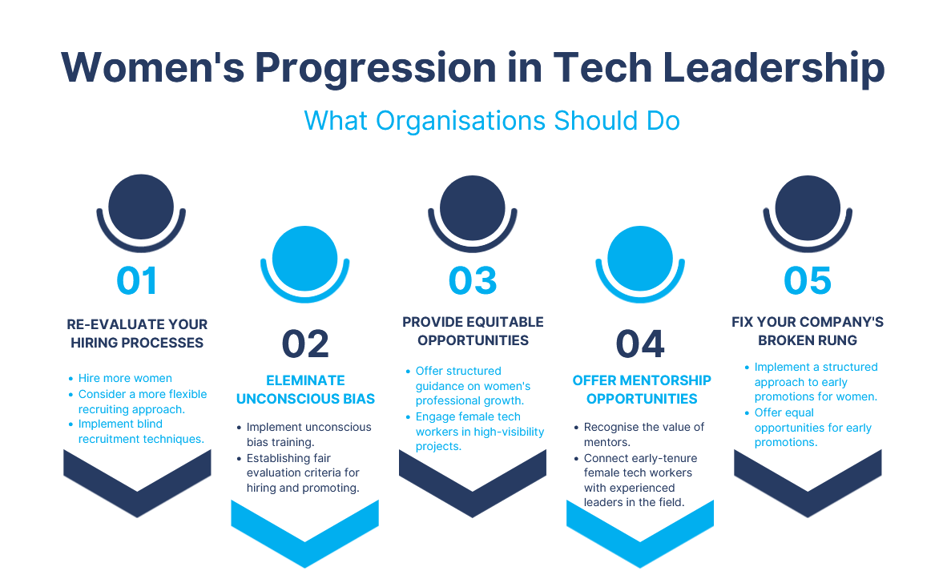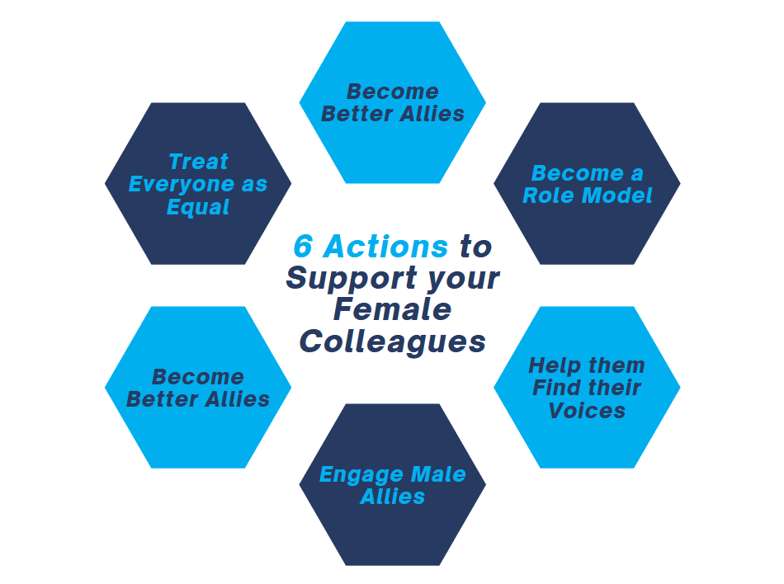Female tech leaders are good for business: Companies with women in key IT positions outperform those dominated by men; they enable more creative thinking, provide positive role models, and have better productivity and overall performance.
The benefits of an equitable gender balance in leadership are well established, but the tech world has yet to fully embrace it. Research indicates that about half of the industry's female workers drop out of technology employment by mid-career, and women hold less than a quarter of the industry's senior leadership roles.

At the same time, a wealth of data show that the women who rise to the top in the tech industry have a strong sense of self-efficacy, are passionate about their work, have positive support at work, and cultivate strong personal and professional networks. Therefore, if you make women passionate about what they do, provide them with challenging work and the needed support, and enable strong networks, they will be more likely to prosper. But, if we already know what women need to stay and succeed in the tech industry, why do they remain largely underrepresented in senior executive roles?
Well, turning the tide is easier said than done. Gender bias remains the top obstacle preventing IT women from moving into leadership positions, and closing the gender gap in tech will require solving challenges beyond retention and equitable promotion.
In the second part of this article, Templeton's tech recruitment experts attempt to find answers and solutions to questions like:
- What can organisations do to enable more female tech workers to advance their careers?
- How can women in IT navigate their way up the ladder?
- And how can women support other talented women in their field to reach their full potential?
Don't miss out on Women in IT (Part 1): Climbing the Ladder of Success to find out why the tech industry needs more female tech leaders and what is stalling women's progression in tech leadership roles.
Advancing & Supporting Women in Tech: What Organisations Should Do
With research showing that diverse leadership can be critical for enabling better business outcomes, companies across industries that seek to shape a prosperous future for themselves are looking to increase the representation of women in their technical and leadership ranks.
However, many organisations fail to understand that improving women's representation in technology calls for the same commitment and strategic focus that underlies other critical organisational initiatives. To drive lasting change, companies need to renew their pledge to advancing gender equality and cultivate an inclusive culture. Formal mentorship programmes and development opportunities for female IT workers and gender targets for promotions could also help improve women's progression to senior executive levels.
Here are some practical steps organisations can take to help women achieve success in the sector:
1. Reconsider your Hiring Process
Raising a more significant proportion of women to leadership roles in tech requires building a solid bench of female employees. Simply put, organisations need to hire more women in the first place. However, with women making up only 26% of all tech applicants, this becomes more of a challenging task.
To inspire a more gender-diverse applicant pool, companies need to devise a flexible recruiting approach that considers women's specific needs and aspirations. Introducing simple changes, such as using gender-neutral language in candidate interviews and across job adverts, can make a difference. Research has found that male-orientated job descriptions and gender-related questions during an interview, such as "Are you pregnant?", can actively discourage women from applying for jobs – and this is particularly prevalent within the tech sector.
Another way to attract female employees is to implement blind recruitment techniques, like blind candidate screening and testing, and even pre-determine that your shortlists will include an equal share of women and men. Furthermore, you can actively search for and hire women. Ask people in your network to refer women candidates to your company, redirect your candidate research to more diverse talent polls, or partner up with a recruitment agency specialising in diversity and inclusion.
2. Implement "Unconscious Bias" Training
Unconscious bias can play a huge role in determining who gets hired, promoted, or left behind. Therefore, companies seeking a gender-balanced tech workforce and leadership need to ensure they have the right strategies to prevent bias from creeping into their hiring and promotion processes.
These strategies include implementing mandatory unconscious bias training for all employees with hiring and promotion responsibilities and creating a diversity toolkit for all managers and HR representatives. According to McKinsey & Company, companies that fail to provide unconscious bias training for employees participating in recruitment processes and performance reviews are more likely to make unfair and gender-biased assumptions about their employees' future potential.
Another initiative that could help eliminate biases is establishing clear evaluation criteria for every stage of the hiring or review process. Moreover, these criteria should be the same for both men and female candidates/employees aiming for the same role/promotion. Research shows that an unbiased third party in the room can also encourage objectivity in these processes. In companies with solid hiring and performance review processes, the most deserving employees are more likely to rise to the top, regardless of gender.

3. Provide Equitable Career Development Opportunities
For a promotion to be successful, the advancing employee should be a good fit for the role, in both skill and personality traits, to thrive and continue to grow in their new position. For this to happen, they need to have access to timely opportunities to upskill, reskill and develop leadership abilities. Equally important is for them to have opportunities to demonstrate their growth and maturity, and readiness to advance.
However, not many are presented with such opportunities, particularly the underrepresented in their industry – such as women in IT. For a considerable number of women in the field, promotions are perceived as unattainable, and many choose to leave.
To make things right, companies can start better supporting women's advancement in technical roles by providing them equitable access to training, projects, and other opportunities to accelerate their skill-building with their male counterparts. Organisations can even expand their traditional career development programmes beyond just technical training. They can offer structured guidance on women's professional growth, sessions on how to be effective in promotion interviews, and opportunities for female tech workers to join high-visibility projects where they can develop their skills on the job. Employers can also provide access to programmes that pair women with sponsors and networking groups.
4. Offer Mentorship Opportunities for Women at Every Level
Mentorship initiatives significantly impact the professional development of women in IT roles. Mentors can help women in technical roles develop leadership and management skills, improve their interviewing abilities, and focus on the skills needed to advance. In fact, a study from Cornell University found that mentoring programmes significantly improved promotion and retention rates for minorities and women compared to other types of diversity initiatives.
Recognising the valuable role of mentors in the professional development of early-tenure tech workers, more and more companies are taking action to help women reach the executive level by connecting them with more experienced people. In most organisations, direct managers are often assigned the task of coaching, advocating, and deciding whether their mentee will get a promotion. However, managers of most entry-level employees have little management training or experience themselves. To address these shortcomings, leading companies invest early in developing managers at lower levels and provide them with extensive training and mentors of their own.
For women in tech, both men and women can serve as mentors. However, they might feel more inspired by someone who has faced the same challenges. Moreover, inviting women to act as mentors can help further promote gender equality in your company.
5. Fix Your Company's Broken Rung
Companies seeking to increase women's representation in technical roles focus most of their efforts on gender parity in new hires and greater equality in executive positions. However, what many of them seem to be missing is another crucial aspect: equitable advancement in early promotions.
Indeed, women in IT are less likely than men to win promotions early in their careers, and companies end up preparing even fewer women for senior tech roles. This phenomenon, known as the "broken rung", is encountered in most companies – including large, Fortune 100 technology companies – and is forcing many women to exit the field.
Here's what you can do to repair your organisation's broken rung and help your female tech employees earn promotions:
- Implement a Structured Approach to Early Promotions: Invest in creating clear and transparent systems for early promotions, with well-defined skills criteria for each role and level. Developing extensive manager training programmes and setting clear bars for when the first two promotions should be expected can also help by adding the aspects of accountability and credibility to these systems. Finally, ensure that your employees have access to projects that will help them gain the skills they need to advance and integrate bias checks into the evaluation processes.
- Offer Equal Opportunities for Promotions: Female tech professionals at organisations that lack an equitable promotion structure for early-tenure employees say they face an upward pathway that can be ambiguous, uneven, and biased. This is because people often make false assumptions about what a woman's career might hold if kids are in the picture. Make sure to afford the women in your company the same benefit of the doubt you extend to men and the same opportunities to earn promotions.

6. Place DEI in the Heart of Your Company Culture
According to a 2021 report from TrustRadius, 72% of women working in tech are outnumbered 2-to-1 at their workplace. Moreover, most of them experience a pervasive "bro culture" (72%), and 78% feel they have to work harder than their male co-workers to prove their worth. And when it comes to promotions, 39% of women in IT see gender bias as the main barrier to getting a C-suite position. This is definitely not an inviting environment for women.
To change that and address gender inequality at all levels of your organisational chart, you can start by embedding diversity and inclusion into the company culture. Here are some initiatives you could implement to support and encourage women to stay and succeed within your organisation:
- Help Women Find their Voice: Simply acknowledging a woman's contributions to a meeting can encourage them to speak up. It also helps them feel seen, heard and valued, which can do wonders in building their confidence and leadership abilities.
- Hire and Promote Female Leaders: Putting women into leadership roles ensures that women at all levels are being represented. Moreover, women need to see other women in senior positions because it shows them that the company values diversity. Hence, they're more likely to want to join and build the confidence they need to fight for promotions.
- Invite Women to Join the Conversation: Women's voices add unique perspectives to conversations. Especially when it comes to diversity or women-in-tech-themed topics, they may be the experts you need in building an inclusive workplace.
- Provide Competitive and Fair Salary: Equal pay for equal work is essential for encouraging women to pursue a career in IT and indicates that a company values gender equity.
- Offer Female-Focused Benefits: Diversity initiatives that include policies for women, like post-maternity support for mothers returning to work, benefits for working mothers and flexible working, are proven to be extremely important for attracting and retaining female tech talent.
- Constantly Re-evaluate Your DEI Strategies: Your workplace practices should align with new diversity and inclusion initiatives at all times to ensure that gender bias won't infiltrate your company culture.
By committing to a holistic diversity, equity, and inclusion strategy, you'll be able to cultivate an inclusive culture and a safe space for women to work and prosper.
7. Follow the "Good Example"
If you want to support women in technical leadership roles but don't know where to start, look at what other organisations are doing and get inspired.
- Aviva
At Aviva, several employees are trained to deliver and run Google #IamRemarkable sessions. The objective of these sessions is to empower underrepresented groups to speak openly about their accomplishments in the workplace and beyond. Alongside this, Aviva runs a leadership programme called "Accelerating Leadership from the Inside Out", which invests in the development of high-potential women leaders to accelerate their development within the organisation.
- Sparta Global
Sparta Global has implemented training initiatives that actively champion and nurture female tech talent to work towards a greater number of promotions. The trainees receive free, commercially relevant technical training. This means that their female hires can develop the fundamental skills they need to thrive in their careers long-term, irrespective of background or previous experiences. Once on the job, their female consultants benefit from ongoing support and mentoring, so they can continue to upskill and advance their careers.
- JPMorgan Chase & Co
The CEO and operating committee at JPMorgan Chase & Co (JPMC) wanted to increase women's representation at senior levels more quickly in order to have diverse perspectives at the top. In 2013, several women on the operating committee launched the Women on the Move programme to connect women executives across JPMC locations around the world. This effort was accompanied by other initiatives, including increased paid parental leave and a ReEntry programme for female employees returning to the industry. Since then, JPMC has increased its representation of women in the C-suite to more than double the industry average.

From Woman to Woman: Actions to Support your Female Colleagues
Are you a CEO, a senior female tech executive or a manager in your organisation? If in a more privileged position than your female colleagues, there are several things you can do to support them in advancing their careers.
- Treat Everyone as Equal: Sure, women support women. But you don't want to end up viewed as biased towards men. To avoid that, treat everyone equally and give transparent and honest feedback on both sides.
- Become Better Allies: Being a good ally often starts with just listening to what your female co-workers are telling you about their experience in the workplace. When you see them dealing with a challenge, ask them how you can help and use your own experiences to help them overcome it. However, when you respond, think about whether you're trying to make them feel better or make yourself feel better.
- Engage Male Allies: According to TrustRadius, 72% of women in tech say they've worked at a company where the "bro culture" is pervasive. But men don't have to contribute to the problem – they can be part of the solution. The presence of male allies is vital to developing a culture that respects women and supports their professional development. Furthermore, it emphasises that we can all make a difference when it comes to diversity in tech.
- Become a Mentor: As a mentor, you'll need to have an active interest in your mentees' work and offer them your knowledge and experience. You'll also need to stimulate new ways of thinking, challenge their preconceptions, and assist them in learning new skills. So, before accepting a mentee, ask yourself: Are you sincerely curious about what your mentee wants to accomplish? Do you have the necessary abilities to assist this individual?
- Become a Role Model: You can be a role model for someone at any time in your life. All it takes is the desire to influence people positively and, most importantly, the openness to be influenced yourself. So, to be a positive role model for your female co-workers, all you have to do is lean into your network of influence, see who can inspire you to reach your potential, and give back to those who are watching and learning from your actions.
- Make Sure Women's Ideas are Heard: Women get less airtime in group discussions, get interrupted more, and are given less credit for their ideas. Set the example by speaking up in meetings, encourage your female colleagues to do the same, and acknowledge their achievements in front of others as often as possible.

How to Shape Your Own Future in Tech
While the tech industry is beginning to support more female leaders, women aspiring to be successful and ascend to leadership positions should also focus on what they can do to avoid mid-career stalls.
Here are some tips on how to navigate your way to the top of the ladder:
-
Build Confidence
Confidence is built through preparation and practice, and the lack of it can be a challenge in a male-dominated field like tech. Ensure that you are fully prepared for whatever might come your way, and don't be afraid to speak your mind. You may find it hard at first, but it will get easier as you go.
-
Understand Your Self-Worth
The fact that women will have to work harder for the recognition they deserve is an unfortunate reality. Women are constantly under pressure to prove themselves and often challenge themselves more than others challenge them. It's okay to be ambitious and want to achieve success, but make sure your reasons for wanting success and your other motivating factors are serving you and not just pleasing others. Also, remember that the path to success can be filled with failures. Embrace these failures, learn from your mistakes and do it better next time.
-
Speak Up
The best way to learn in the tech field is to jump in and get your hands dirty. As a woman, you might need to fight for that right often since opportunities won't always come your way. Similarly, moving up the ranks will not come naturally, and you might have to make your own place within the company. Learning how to negotiate and speak up confidently in the workplace can lead to a faster career progression. Moreover, standing up for yourself, being proud of your achievements and sharing your wins may inspire other women to do the same.
-
Find Ways to Keep Growing
Constantly seek new and creative ways to grow in your field, and keep your skills relevant and up to date. However, strong technical expertise won't directly lead you to a promotion. You'll also need to develop in other areas, like management, communication and leadership. The best way to learn new things sometimes is to ask people who are more experienced than you. Don't be intimidated by them and don't be afraid to ask questions if you have problems understanding. As long as you continue learning and exploring new areas, you are on the right path to becoming a future tech leader.
-
Find a Mentor
You can gain tangible opportunities, social connections, and visibility through mentorship. Having a mentor means having someone inspirational close to you, willing to invest in and work with you. So, it's important that you feel comfortable with your mentor; you can freely ask for their guidance whenever you need it, and you can learn and get inspired by them. If your company doesn't provide you with a mentor, there are many great mentor programmes out there to help you find the right person to support you, help you build confidence, gain knowledge, and achieve career progression by learning from their experiences.
-
Network
Female leaders and women in tech have come a long way, but they still have a long way to go to achieve equal opportunities and representation at all levels. Therefore, a solid network of people supporting your career is crucial. As daunting as it may seem, networking requires you to get yourself out there, connect with experts in your field, and listen and talk to them. Networking is also an excellent way to find a potential mentor or sponsor to elevate your career faster.

The Good News
Women in IT are gaining ground as the industry makes slow but steady progress in shrinking its gender gap, and women in leadership roles are making the fastest advances. Deloitte Global predicts that large global technology firms, on average, will reach nearly 33% overall female representation in their workforces in 2022, up slightly more than 2% from 2019.
These numbers predict a brighter future for women in tech, and we can do even better once we understand that promoting female leadership in the industry is a collective responsibility. Employers, managers, mentors and educators, the women in the field and their male colleagues must all work together to tackle the biases and create a more inclusive culture from the inside out.
Don't miss out on Women in IT (Part 1): Climbing the Ladder of Success to find out why the tech industry needs more female tech leaders and what is stalling women's progression in tech leadership roles.
Ready to Take the Next Step?
If you want to support women in the tech industry and encourage diversity and inclusion in the workplace, start by hiring more diverse talent.
Templeton has over 26 years of experience recruiting highly skilled and diverse IT contractors across the world – find out more about our award-winning tech recruitment services.




